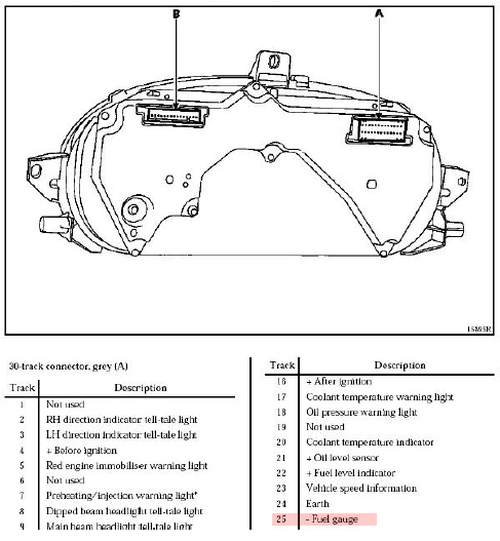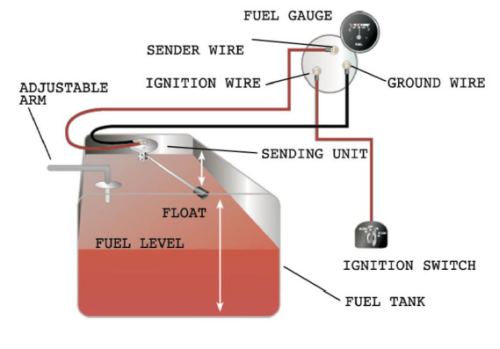Difference between revisions of "Analog Fuel Sensor"
(Created page with "==Analog Fuel Sensor Connection== frame|Example of service manual describing insturment cluster pinout General procedure of connection a...") |
|||
| Line 29: | Line 29: | ||
<br> | <br> | ||
------------ | ------------ | ||
| − | [[File:Fuel Gauge.png | + | [[File:Fuel Gauge.png|frame|Typical Fuel Sensor and Fuel Gauge connection]] |
| − | Typically, the fuel sending wire will come from a multiple | + | Typically, the fuel sending wire will come from a multiple wire connector along with all the other dashboard inputs. |
| − | wire connector along with all the other dashboard inputs. | ||
<br> | <br> | ||
- With no manual, wires coming from the fuel gauge have to be tested by measuring their current, then reducing the amount of fuel in the fuel tank and then measuring '''current''' again. The wire that has reduced '''current''' in response to less fuel is the fuel sender wire. All the wires have to be measured between each change in fuel level. The fuel sending wire is typically red or pink, but this is not guaranteed to be true | - With no manual, wires coming from the fuel gauge have to be tested by measuring their current, then reducing the amount of fuel in the fuel tank and then measuring '''current''' again. The wire that has reduced '''current''' in response to less fuel is the fuel sender wire. All the wires have to be measured between each change in fuel level. The fuel sending wire is typically red or pink, but this is not guaranteed to be true | ||
<br> | <br> | ||
- A more direct way of finding the fuel sending wire is to take out fuel sensor from the fuel tank and move the floating arm from full to empty while measuring the current of the wires. This should be done with electronics on and without ignition (key in ACC position). Fuel tank should also be empty for safety reasons, and trying to turn ignition on in this situation is likely to damage internal components. | - A more direct way of finding the fuel sending wire is to take out fuel sensor from the fuel tank and move the floating arm from full to empty while measuring the current of the wires. This should be done with electronics on and without ignition (key in ACC position). Fuel tank should also be empty for safety reasons, and trying to turn ignition on in this situation is likely to damage internal components. | ||
Revision as of 14:52, 13 September 2021
Main Page > Accessories > Analog Fuel SensorAnalog Fuel Sensor Connection
General procedure of connection and calibration for an analogue
FLS (fuel level sensor)
Find the fuel sender wire:
- Easiest way to find fuel sending wire is to consult a car service manual or wiring diagram for the instrument panel. A lot of them can be found online by searching for "<your car model> service manual". The exact pin and wire can usually be found without having to test everything.
- Fuel sending wire will have variable voltage based on how much fuel the sensor is detecting. Without any manuals, fuel sending wire can be detected by measuring changes in voltage after filling/emptying fuel tank. Sensors can go from LOW voltage = FULL; HIGH voltage = EMPTY, or in reverse. The ranges can also vary, so there’s no way to know beforehand what voltage is supposed to be full and what voltage is supposed to be empty.
Typically, the fuel sending wire will come from a multiple wire connector along with all the other dashboard inputs.
- With no manual, wires coming from the fuel gauge have to be tested by measuring their current, then reducing the amount of fuel in the fuel tank and then measuring current again. The wire that has reduced current in response to less fuel is the fuel sender wire. All the wires have to be measured between each change in fuel level. The fuel sending wire is typically red or pink, but this is not guaranteed to be true
- A more direct way of finding the fuel sending wire is to take out fuel sensor from the fuel tank and move the floating arm from full to empty while measuring the current of the wires. This should be done with electronics on and without ignition (key in ACC position). Fuel tank should also be empty for safety reasons, and trying to turn ignition on in this situation is likely to damage internal components.

